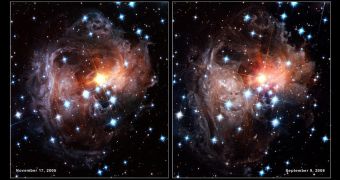According to the conclusions of a new study conducted by an international team of astronomers, it would appear that some of the weird, donut-shaped dust clouds observed around supermassive black holes may contain debris left behind by high-speed collisions between extrasolar planets and asteroids.
The violent cosmic impacts may have pulverized the objects, turning them into dust and pebbles. These debris then enter orbit around a black hole, waiting for their orbit to decay, and for them to be swallowed up by the dark behemoth.
These conclusions were extracted from a study of supermassive black holes. Such objects are located at the core of all giant galaxies. Previous investigations determined some time ago that numerous such objects had mysterious dust clouds surrounding them.
In fact, as many as 1 in 2 such black holes were obscured by the weird dust clouds. Until now, scientists had no clue as to where these structures may have originated. The new study is the first to propose that cosmic collisions between planets and asteroids are responsible for their creation.
One of the main implications the new study has is that galactic cores contain exoplanets and asteroids too. Thus far, astronomers believed that central galactic regions were populated exclusively by stars and black holes, Space reports.
“Too bad for life on these planets, but on the other hand the dust created in this way blocks much of the harmful radiation from reaching the rest of the host galaxy. This in turn may make it easier for life to prosper elsewhere in the rest of the central region of the galaxy,” Sergei Nayakshin said.
The expert, an astronomer at the University of Leicester in the United Kingdom, was the lead author of the new paper detailing the findings. The work will be published in an upcoming issue of the esteemed journal Monthly Notices of the Royal Astronomical Society.
The scientist explains that the extreme environments around black holes would have prevented life from developing on these destroyed planets regardless of whether they were impacted by asteroids or not. Extreme levels of radiation can be found all around black holes, astrophysicists say.
“We suspect that the supermassive black hole in our own galaxy, the Milky Way, expelled most of the gas that would otherwise turn into more stars and planets,” Nayakshin explained in the statement.
“Understanding the origin of the dust in the inner regions of galaxies would take us one step closer to solving the mystery of the supermassive black holes,” the researcher concluded.

 14 DAY TRIAL //
14 DAY TRIAL //